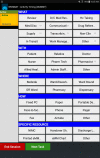Stepped-wedge cluster randomised controlled trial to assess the effectiveness of an electronic medication management system to reduce medication errors, adverse drug events and average length of stay at two paediatric hospitals: a study protocol
- PMID: 27797997
- PMCID: PMC5093386
- DOI: 10.1136/bmjopen-2016-011811
Stepped-wedge cluster randomised controlled trial to assess the effectiveness of an electronic medication management system to reduce medication errors, adverse drug events and average length of stay at two paediatric hospitals: a study protocol
Abstract
Introduction: Medication errors are the most frequent cause of preventable harm in hospitals. Medication management in paediatric patients is particularly complex and consequently potential for harms are greater than in adults. Electronic medication management (eMM) systems are heralded as a highly effective intervention to reduce adverse drug events (ADEs), yet internationally evidence of their effectiveness in paediatric populations is limited. This study will assess the effectiveness of an eMM system to reduce medication errors, ADEs and length of stay (LOS). The study will also investigate system impact on clinical work processes.
Methods and analysis: A stepped-wedge cluster randomised controlled trial (SWCRCT) will measure changes pre-eMM and post-eMM system implementation in prescribing and medication administration error (MAE) rates, potential and actual ADEs, and average LOS. In stage 1, 8 wards within the first paediatric hospital will be randomised to receive the eMM system 1 week apart. In stage 2, the second paediatric hospital will randomise implementation of a modified eMM and outcomes will be assessed. Prescribing errors will be identified through record reviews, and MAEs through direct observation of nurses and record reviews. Actual and potential severity will be assigned. Outcomes will be assessed at the patient-level using mixed models, taking into account correlation of admissions within wards and multiple admissions for the same patient, with adjustment for potential confounders. Interviews and direct observation of clinicians will investigate the effects of the system on workflow. Data from site 1 will be used to develop improvements in the eMM and implemented at site 2, where the SWCRCT design will be repeated (stage 2).
Ethics and dissemination: The research has been approved by the Human Research Ethics Committee of the Sydney Children's Hospitals Network and Macquarie University. Results will be reported through academic journals and seminar and conference presentations.
Trial registration number: Australian New Zealand Clinical Trials Registry (ANZCTR) 370325.
Keywords: Adverse drug events; Electronic Prescribing; Medication errors; PAEDIATRICS; hospital medication systems; medical order entry systems.
Published by the BMJ Publishing Group Limited. For permission to use (where not already granted under a licence) please go to http://www.bmj.com/company/products-services/rights-and-licensing/.
Conflict of interest statement
Conflicts of Interest: None declared.
Figures





References
-
- Kaushal R, Barker KN, Bates DW. How can information technology improve patient safety and reduce medication errors in children's health care? Arch Pediatr Adolesc Med 2001;155:1002–7. - PubMed
-
- Gazarian M, Drew A, Bennett A. Medicinal mishap. Intravenous paracetamol in paediatrics: cause for caution. Aust Prescr 2014;37:24–5.
-
- Kim GR, Chen AR, Arceci RJ et al. . Error reduction in pediatric chemotherapy: computerized order entry and failure modes and effects analysis. Arch Pediatr Adolesc Med 2006;160:495. - PubMed
-
- Kaushal R, Bates DW, Landrigan C et al. . Medication errors and adverse drug events in pediatric inpatients. J Am Med Assoc 2001;285:2114–20. - PubMed
Publication types
MeSH terms
Substances
LinkOut - more resources
Full Text Sources
Other Literature Sources
Medical
